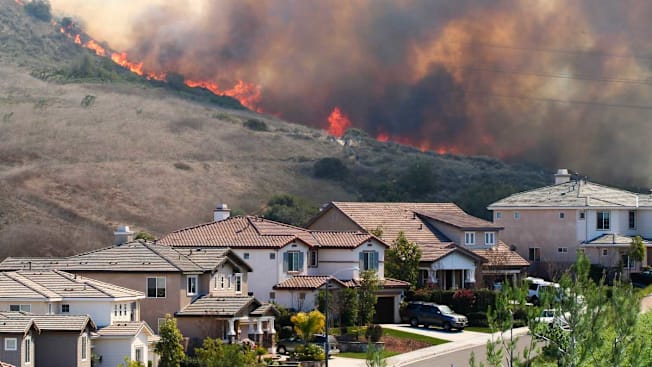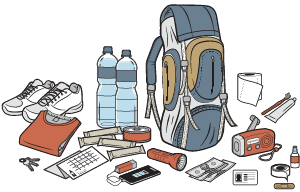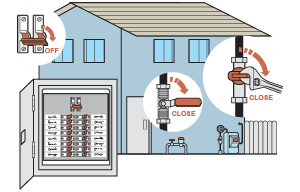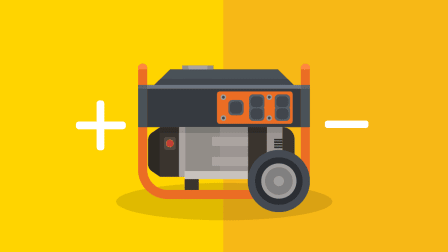How to Prepare Your Home and Family for Wildfires
Smart landscaping, building materials, and home maintenance can keep your home safer. Plus, how to prepare to evacuate if necessary.

In 2024, wildfires burned nearly 9 million acres across the U.S., more than three times the previous year’s total, according to the National Interagency Fire Center. That’s an area larger than Maryland, and it extends the trend of fires becoming more intense and widespread.
That was before the Los Angeles fires. in January 2025, the Altadena and Pacific Palisades fires destroyed 16,000 buildings and caused up to $131 billion in damages, making it the state’s most expensive wildfire disaster on record. And while wildfires are still concentrated in the West and Southwest, they are now hitting places that rarely saw them before, including Hawaii, Canada, and the East Coast.
Plan Your Emergency Escape
Make an evacuation plan. Set up multiple means of communication in advance. Place your go bag where it’s easy to grab. If time permits before evacuating, close and lock windows and doors, and shut off utilities (see below).
How to


Plan alternate evacuation routes. Trace several routes on paper maps and keep them in your vehicles and go bags. "You don’t want to have to figure that out at 2 in the morning as all hell is raining down on you," says MacAdam Lojowsky, whose family and pets survived the raging 2017’s North Bay Fire in Redwood Valley, Calif. Lojowsky says he and his wife immediately adapted to a new driving route when their first route was blocked by a blaze.
Keep your gas tank filled. "Never let it go below half a tank," Lojowsky advises.
Practice packing and fleeing. "Give yourself 30 minutes to leave," says David Ofwono, director of First on Compliance, an emergency preparedness consulting company based in California. "Sometimes a wildfire moves so fast, that’s all the time people have. In the Palisades fire, many residents wasted precious minutes trying to fight the flames with garden hoses. By the time they realized it was futile, their window to evacuate had nearly closed."
Learn to shut off your utilities. Label your water main, electrical box, and gas shutoff valves, and practice turning them off. Ready.gov, a resource from the Department of Homeland Security, recommends checking with your gas company to learn the correct steps, since meter configurations can vary. When practicing, don’t actually turn the gas off. If you ever do need to shut it off, leave it off until a qualified professional can turn it back on safely.
How to


Prepare for Fire at Home
Have more than one escape plan from your home. Consider a Plan A, B, and C for every room in your house. Plan A is walking through a front or back door as you usually do. Plan B is your escape through a window when the door is blocked. Plan C is when fire or smoke prevents you from escaping a room. Get details on escape plans and more ways to prepare from the National Fire Protection Association.
Keep smoke detectors up to date. Interconnected smoke alarms can improve early detection because they all sound at once if any of them senses a problem. Make sure the batteries are working by testing the units monthly, and change them out every 10 years. Place one, at minimum, on every floor of your home—and don’t forget the basement. Ideally, place them in hallways outside bedrooms, and in sleeping areas themselves. Check CR’s free ratings of smoke and carbon monoxide detectors for top models.
Install escape ladders. Place them outside the windows of every upper-floor room.
Stay Safe in Smoky Conditions
Keep N95 masks available for going outside. If you’re smelling wildfire smoke, chances are that unhealthy microscopic smoke and soot particles are entering your lungs. Wear an N95, KN95, or P100 mask that fits snugly around your nose and mouth—the same kind used to protect against the COVID-19 virus—to protect against smoky, sooty conditions.
Invest in an effective air purifier. The air purifiers that do well in CR’s air-purifier tests proved in our labs to be good at filtering dust, smoke, and pollen from the air. Multiple studies of room air purifiers show that using HEPA filters results in reductions of 50 percent or higher in particulate matter. In one 2018 study of about 130 households, filtration resulted in about a 30 percent reduction in coarse particles, like dust. In a pinch, make an air purifier from a box fan and air filter. Run the purifier on high with doors and windows closed for maximum effectiveness.
Get the right HVAC air filter. The best HVAC air filters from CR’s tests did an excellent job of removing dust, pollen, and smoke from a room. Consumer Reports recommends looking for a filter with a high MERV (minimum efficiency reporting value) rating, which signifies an air filter’s effectiveness. A MERV rating of 13 is the highest rating you’ll find for most of the popular residential HVAC filter sizes.
Make Your Outdoor Space ‘Defensible’
Clear away combustibles. Keep flammable materials at least 5 feet from your home and 30 feet from decks, overhangs, and wood piles. Avoid outdoor furniture that easily catches fire, like wicker or untreated hardwood. For more ideas, check out this CalFire guide on creating a defensible space.
Keep the yard clean. Regularly remove dead leaves, pine needles, and plants from gutters, under decking, and within 30 feet of your home. If possible, trim tree branches at least 10 feet from chimneys and other trees, and clear overhanging branches from your roof. Use gravel or stone mulch instead of organic material, and keep grass no higher than 4 inches.
Landscape with fire in mind. Plants with lots of waxes, oils, and resins are not good choices because they’re more likely to catch fire, CalFire says. In contrast, plants with a higher moisture content in the leaves, are better suited to resist fire. But where you place your plants—and how well you prune, maintain, and clean up dead and dry foliage—is just as important. "Landscaping practices . . . can have a greater impact on whether a plant ignites than does the type of plant it is," CalFire advises. Instead of relying on a fire-resistant plant list, consult a local nursery, landscape contractor, or cooperative extension service for the best options for your area.
Hardscape right. Add fire breaks using gravel, decomposed granite, or stone walls to slow a fire’s spread.
Build in Fire Resistance for Long-Term Protection
Rethink building materials. Consider noncombustible siding materials, such as fiber cement, brick veneer, and stucco, the Insurance Institute for Business & Home Safety (IBHS) recommends. For decks, opt for a metal-joist substructure. If you have a wood or vinyl fence, replace the section next to your house—at least 5 feet—with metal; fire often spreads from home to home via fences and decks, the IBHS says.
Upgrade the roof. This part of your house is your first line of protection against wind-borne embers. Make sure your new roofing material is labeled Class A—the highest fire-resistance rating. (Those materials can include asphalt shingles, metal sheets, and concrete or clay tiles.) Replacing a very old roof can help you save on homeowners coverage. A recent PolicyGenius analysis shows that major insurers charge anywhere from around 12 percent to over 40 percent more for a 20-year-old roof compared with a new one—a jump averaging about 23 percent overall. For the best options, check CR’s ratings of asphalt roofing shingles.
Act now to keep your home insured. If you live in a wildfire-prone area, getting or keeping homeowners insurance is getting harder. Some insurers are raising rates, cutting coverage, or pulling out altogether, leaving some homeowners to self-insure, which can be a risky bet. Check your policy now, make sure you understand what’s covered, and look into fire-resistant upgrades that could help preserve your policy. If you’re struggling to find coverage, a broker may be able to help, or you can check if your state has a last-resort plan like California’s FAIR Plan.
@consumerreports Do you have an effective air purifier? The air purifiers that do well in our air-purifier tests proved in our labs to be good at filtering dust, smoke, and pollen from the air. Learn more through the link in our bio. #wildfiresmoke #wildfireseason
♬ original sound - Consumer Reports




















